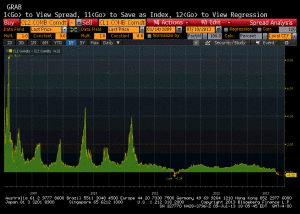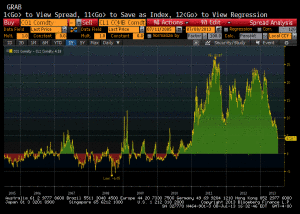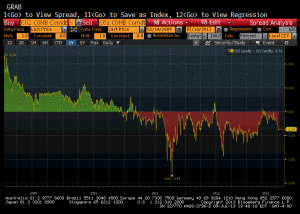The Low-Down on WTI
Paolo Santos on Seeking Alpha wrote an interesting piece titled “Weirdness Strikes the Crude Oil Market” and the current situation, on the surface, is weird. After all, according to the EIA, stockpiles of crude are essentially at the highest level in its time series. This is during a time that domestic production has dramatically increased and is expected to continue increasing. One would be forgiven for being surprised that WTI broke out of its range to higher prices. Front month WTI futures are around $103. The last time WTI traded $103 was May 2012 and that was before stockpiles went much higher than 350M barrels (they are currently close to 400M barrels). Here is a thesis to try to make sense of higher spot WTI prices amid supply.
Background
As background, the WTI-Brent spread that exploded to Brent’s favor reaching close to $25 has now collapsed below $5. Keep in mind that Brent is the inferior crude oil as it costs more to crack. Meaning, all things being equal, WTI should trade higher than Brent. All things, of course, were not equal.
Also, there was a tremendous amount of passively indexed commodity investing. Passive commodity investing is essentially always done as investment in futures and is based on three sources of return: spot price change, collateral return and roll yield. Spot price change is the change in price of the commodity itself and is what everyone is most familiar with in commodities investing. Passive investment is done using futures. One earns a collateral return on posted margin, which is usually a Treasury Bills. Most indices and funds, such as the Goldman Sachs Commodity Index (GSCI) and United States Oil ETF (USO) purchase front month futures and, near expiration, “roll” into the next month. That is, the fund sells the front month and buys the second month. If one is able to sell the front month at a higher price than the second month, then this earns a roll return. The opposite occurs if the second month is higher. When the front month is higher than the second, this is called backwardation and the reverse (2nd month higher than front month) contango. Indexed investors want backwardation to earn roll yield. As it turns out, the historical source of returns in commodities comes from the collateral and roll returns; spot price returns are volatile and average out over time (source: Expected Returns, Ilmanen).
The index and ETF investors became a very large part of the crude oil market. The impact was big enough that their futures expiration trading got its own name, the “Goldman Roll,” along with a Wikipedia page. The futures market has long since adjusted for the roll, but the point is that index investing has been a large part of the energy market for some time. That impact eventually hammered the crude oil futures market from backwardation to contango (ascribing causes in the markets can be a sketchy proposition but given the circumstances this looks like the most sensible conclusion). What is evident is that for index investors, their collateral margin was held to nearly 0% on TBills and their roll yield was now negative due to contango in the WTI market. It appears that when real yields popped from negative to positive (10 year TIP yields as proxy have move from about -.7% to .6% in 2 months – absolutely staggering), commodity investors threw in the towel and sold their underperforming funds. All three legs had negative expectations. Although I don’t have figures showing outflows from GSCI indexing, as proxy we can follow the path of USO, where outstanding shares have been on a clear, though erratic, trend down since Dec 2012. Since the beginning of 2013, shares outstanding have fallen from around 35M to 18.8M as last reported (source: Bloomberg).
The Crude Carry Trade
Here is a graph of the difference between the 2nd calendar WTI contract and the 1st (Bloomberg); green (positive) indicates contango and red (negative) backwardation.
Contango allows those with storage capability to buy spot crude oil to store in Cushing (the WTI delivery point) so that they could then sell the forward at a higher price earning a nice yield in the process. There is a cost to storing the oil and the rule of thumb is the cost is 45-50c per month. That coincides with the median value for the spread at 49c over the period. But the average value is 77c with a high of $8.19. One can see the volatility on the chart above. So long as things don’t look they are going to stay in backwardation, it pays to store oil and withhold it from the market. Most of the time (the median), you will break even. But on average, you can earn 27c to 32c per month due to occasional spikes. That works out to 3.6-4.3% returns in a world of ZIRP. That is far better than the passive index investor was doing and without the volatility of spot prices. In fact, it was the index investors who were assuming the volatility of the spot price and paying the carry traders to store the oil that they had purchased in the futures market.
Now WTI is in backwardation. Those in the crude carry trade need to consider the persistence of the backwardation. There has been significant withdrawal of passive investor index money. Just as passive investor demand forced crude oil into contango from backwardation, it stands to reason that flows the other way (the exit of the passive investor) would usher backwardation back. Given the evidence of investor preferences to exit passive indexing, it makes sense for the WTI carry traders to reduce their risk.
WTI-Brent Spread
The EIA released figures last week that pushed WTI higher due to a drawdown of stocks by 10M barrels. Look at those figures and note that the bulk of the drawdown is due to lower imports. Think for a moment and it makes perfect sense: traders had been diverting oil headed to other delivery points, e.g., Brent, to send to Cushing in order to satisfy end-user oil demand play the carry trade. Of course, the crude is still being produced somewhere and has to be delivered. Now that there is no carry to earn, it makes sense to send it to the Brent delivery point and make 5 extra bucks per barrel.
If all of that makes sense, then it stands to reason that your thinking would follow mine. And after going through this, I figured I could test the hypothesis by checking what the Brent term structure looked like over time. I expected to find that the WTI-Brent spread blow out coinciding with Brent moving into backwardation. If backwardated, Brent would no longer be a desirable place to store crude because there would be no carry trade. Here is the history of the Brent premium (Bloomberg):
And here is the same calendar spread graph (2nd – 1st ) but for Brent crude:
Note that in mid-to-late 2010 Brent moved from contango to backwardation and that was when the Brent-WTI spread began to expand. And it has stayed wide until now, when the WTI contango gave way to backwardation. Certainly it began with some fits and starts. Moving oil is not stock trading; it takes time and resources and then builds momentum. Presumably the trade gets very crowded in 2011 and becomes volatile. Nevertheless the data fits the theory. Interestingly, there were several articles in 2009 and early 2010 covering the carry trade in the Brent market.
Why then is crude staging a strong rally despite the fact that domestic US production is high and climbing plus stocks are near all-time highs? The hidden truth is that it actually is not. Brent is not making any 52 week highs and is about $1 higher than a month ago. Brent was about $120 in Feb 2013 and now is $107ish. As it turns out, that type of performance also holds for crude futures one year out. 12 Month WTI has not even traded higher than where it was in June, just a month ago. So what has happened is that 1) spot WTI is converging with Brent bringing it higher 2) there was an overall boost to the market from the drawdown and payroll figures and 3) there is general uneasiness due to news from Egypt.
Further evidence of the impact of both the carry trade and commodity index investors comes from discussions with a NY options trader. He noted that non-WTI domestic oils traded more in line with Brent than WTI. Another, a products options trader, noted that heating oil and gasoline traded closer with Brent which matches the data point that other grades of domestic oil that would be used for those products traded like the commodity (Brent), not the financial collateral (WTI). Those data points indicate that WTI is/was the aberration, not Brent. WTI, after all, is the futures market used by indexers and the market that offered the contango opportunity, not Brent and not Gulf Coast sour.
Conclusion
So the apparent weirdness that is in the crude oil market turns out to not be weird, but instead signals a shift in the crude oil marketplace. Crude and other commodities were used as collateral in financing transactions – essentially physical repo. Higher real rates, tighter money, passive investor withdrawal and backwardation have eliminated the financial motivation for withholding oil from the market. It stands to reason that WTI crude will again trade more like a commodity instead of a carry asset – at least so long as passive indexers are leaving the market.



